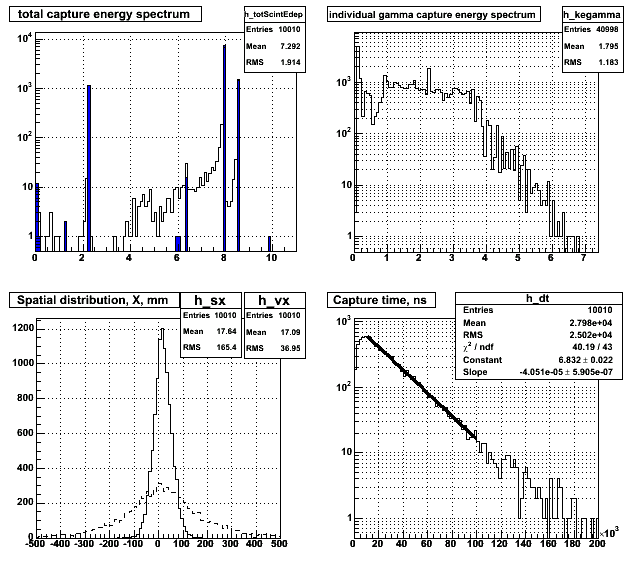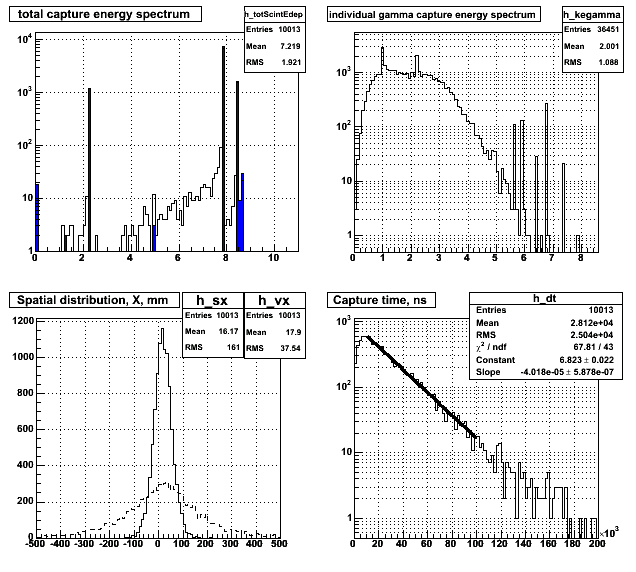Additional gadolinium support for GLG4sim
Gadolinium loading is a key part of most proposed liquid scintillator
antineutrino experiments. While support for n capture on Gd in Geant4
has improved greatly recently, the modelling of the Gd gamma cascade still
can benefit from some "unblessed" external code.
The current distribution of the Geant4 Neutron Data Library (NDL),
version 3.8, includes enough data for Gd to give a reasonable
approximation of the continuum gamma spectrum after neutron capture,
but does not include discrete gamma lines for high-energy gammas
which arise in 1~2% of all neutron captures on Gd.
Proper modelling of the discrete high-energy gammas may be
important if they can escape the active volume of the detector,
resulting in a low total energy deposition that
causes the neutron capture on Gd to be missed in the offline analysis.
To allow this effect to be studied, here is some non-standard,
un-"blessed" code, generously contributed by its author, in the hope
that it will be useful, but without any warranty, guarantee,
testimonial, tacit assumption of functionality, or anything like that.
- Karim Zbiri (Subatech-Nantes) has created a non-standard,
un-"blessed" mutation of some of the G4NeutronHP* models which
contains explicit code for Gadolinium gamma final states. The code
may be found in this tar file. The tar
file also contains installation and usage instructions. Note that the
instructions refer to the tar file by a slightly different name than
the one used on this web page: please don't be confused by that.
Note that your Gadolinium-containing Geant4 simulation with
neutrons will still crash, even with this code, unless you have real
cross-section data and some sort of final state data for
Gadolinium. The best solution is to use the latest version of the
Geant4 Neutron Data Library (G4NDL), which is version 3.8 as of this writing.
Below are two sets of plots showing comparisons of the results with
and without this code. In the "total capture energy spectrum", the
filled histogram shows the total energy of gammas produced anywhere in
the detector, and the open histogram shows the total energy deposited
in the scintillator, in a variant of GLG4sim's standard cylindrical
geometry modified to have Gd loading in the central detector. Note
the absence of capture on C in the second plot -- this is apparently a
bug. The "individual gamma capture energy spectrum" shows the
spectrum of any single gamma. Note high energy lines in the second
set of plots, absent in the first -- this is the main benefit of
using this special code. In the "spatial distribution" plot, the solid
histogram shows the capture position, while the dashed histogram shows
the apparent centroid of energy deposition, a wider distribution due
to the propagation of the gamma rays.

Above: Standard G4 capture.

Above: Zbiri G4 capture.
Note that with the release of G4NDL 3.8, it is no longer necessary to
use unofficial Gd data: the new neutron data library has it all.
Download
here.
Thanks, Geant4 team!
Deprecated makeshift data: - Matt Worcester (University of
Chicago) has created some non-standard, un-"blessed" data files for
neutron elastic and capture processes on Gadolinium and Samarium,
using data freely obtained from the ENDF evaluations. The data may be
found in this tar file. The tar file
also contains a script to copy the data to the correct place in your
existing
NeutronHPCrossSections directory. Unpack the
tar file, change to the MWneutron directory it creates, and run the
script. You will need to have the NeutronHPCrossSections
environment variable set, and to have write permission for the
NeutronHPCrossSections directory. Note that this data
does not include real "final state" data for the Elastic and Capture
processes. The script simply copies Indium isotope data to make
bogus Gadolinium and Samarium final state files. This file is
no longer necessary now that G4NDL 3.8 has been released!
2006/03/12


